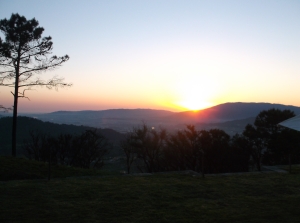There are all kinds of ways that you can get yourself to remember things. You can remember things by repeating them over and over again. You can remember things by using clever memory systems like mnemonics, the Roman Room or the number-rhyme system. You can remember things by making notes and diagrams of them, or recording and listening to them. And you can remember things by making them more memorable. The most memorable things tend to have certain features. Moments of joy, excitement, shock or horror stick, as does anything unexpected. Multi sensory experiences tend to drive a memory in deep as well.
For years now, we have looked across at the wind turbines on the top of the Serra d’Arga and wondered how tall they are. We’ve tried a couple of times to get up there, but the Portuguese do a great line in disappearing road signs. Of course, we could have looked the answer up online and found out how tall they were. We could have memorised their height and got full marks in an exam if the question ever cropped up. But somehow that is not quite the same as actually going to see them in real life. Luckily, the Portuguese approach to health and safety meant that, when we finally found the dirt track to the top of the mountain, so long as we didn’t mind destroying the paintwork on our car, we could see the field of turbines at the top. And we discovered that, if you want to remember how tall a wind turbine really is, you have to make the memory for yourself.



A couple of things occurred to me, reading this:
– Whilst emotional or surprising things are often memorable, I don’t think we as teachers can rely on them being so. It’s possible that there have been lots of exciting or memorably things in my life that I’ve forgotten about; but I don’t know how many, because I’ve forgotten them.
– I feel like what you’ve written here is implicitly in defence of discovery learning. I am against that as a thing, but I agree with what you’re saying here. If I were doing the poem ‘Daffodils’ in class, and there was a field of daffodils outside, I would take my class outside and read the poem with the daffodils right there. I like to think they’d understand, in some undefinable way, the poem better in some way too.
– As you present the case here, you can have it both ways: go see the wind turbines, then come back and look up how tall they are, when they were made, etc.
LikeLike